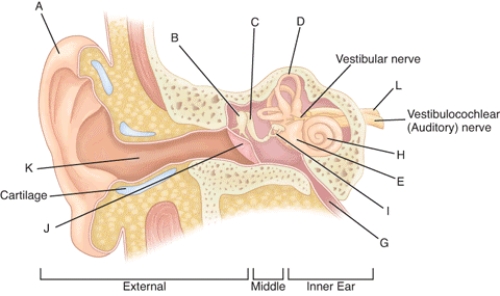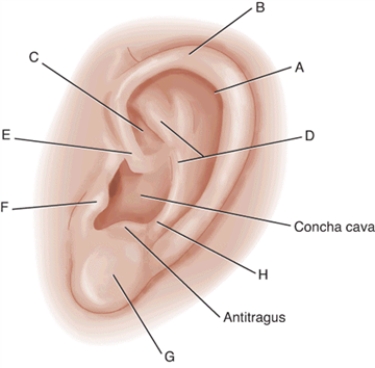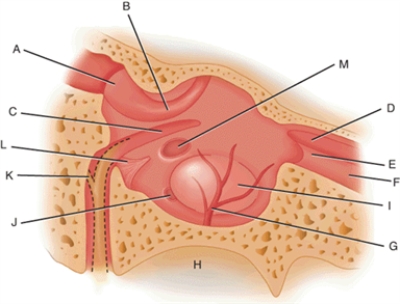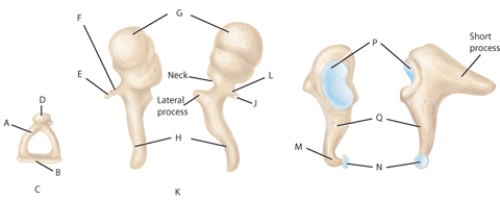Correct Answer

verified
Correct Answer
verified
Multiple Choice
The pars flaccida is
A) the most flaccid portion of the external auditory meatus.
B) a portion of the eardrum with the least fibrous tissue.
C) another name for the umbo.
D) none of the above.
F) A) and B)
Correct Answer

verified
Correct Answer
verified
Multiple Choice
Match the structure to which each of the following landmarks belongs. Terms may be used more than once or not at all. -Helicotrema
A) vestibule
B) semicircular canals
C) cochlea
D) middle ear
E) outer ear
G) C) and E)
Correct Answer

verified
Correct Answer
verified
Short Answer
Match each structure or landmark to the correct descriptor. Terms may be used more than once or not at all.  -Eustachian (auditory) tube
-Eustachian (auditory) tube
Correct Answer

verified
Correct Answer
verified
Short Answer
Match each structure or landmark to the correct descriptor. Terms may be used more than once or not at all.  -Helix
-Helix
Correct Answer

verified
Correct Answer
verified
Multiple Choice
Match each term to the correct descriptor. Terms may be used more than once or not at all. -Nerve that conducts information concerning sound and position in space
A) semicircular canals
B) cochlea
C) VIII vestibulocochlear nerve
D) VII facial nerve
E) malleus
F) incus
G) stapes
H) stapedius
I) tensor tympani
K) A) and D)
Correct Answer

verified
Correct Answer
verified
Multiple Choice
The epithelial lining of the external auditory meatus
A) continues as both the superficial and deep layers of the tympanic membrane.
B) relies upon secreting epithelial cells of the middle ear for lubrication.
C) continues as the superficial layer of the tympanic membrane.
D) none of the above.
F) A) and D)
Correct Answer

verified
Correct Answer
verified
Short Answer
Match each structure or landmark to the correct descriptor.  -Pyramid
-Pyramid
Correct Answer

verified
Correct Answer
verified
Multiple Choice
Match each term to the correct descriptor. Terms may be used more than once or not at all. -Bone that projects into the epitympanic recess
A) semicircular canals
B) cochlea
C) VIII vestibulocochlear nerve
D) VII facial nerve
E) malleus
F) incus
G) stapes
H) stapedius
I) tensor tympani
K) G) and H)
Correct Answer

verified
Correct Answer
verified
Short Answer
The ____________________ of the malleus extends into the epitympanic recess of the middle ear.
Correct Answer

verified
Correct Answer
verified
Multiple Choice
The chorda tympani
A) is a blood vessel that first surfaces in the external auditory meatus and passes into the middle ear space at the inferior margin of the tympanic membrane.
B) is a branch of the VII facial nerve.
C) can sometimes be seen through the superior tympanic membrane during otoscopy.
D) a & b
E) b & c
G) A) and D)
Correct Answer

verified
Correct Answer
verified
Short Answer
Match each structure or landmark to the correct descriptor. Terms may be used more than once or not at all.  -Long process of incus
-Long process of incus
Correct Answer

verified
Correct Answer
verified
Short Answer
Match each structure or landmark to the correct descriptor. Terms may be used more than once or not at all.  -Facial nerve
-Facial nerve
Correct Answer

verified
Correct Answer
verified
Multiple Choice
Match each term to the correct descriptor. Terms may be used more than once or not at all. -Bone that articulates with the inner ear
A) semicircular canals
B) cochlea
C) VIII vestibulocochlear nerve
D) VII facial nerve
E) malleus
F) incus
G) stapes
H) stapedius
I) tensor tympani
K) C) and H)
Correct Answer

verified
Correct Answer
verified
Short Answer
The (specific bone) ____________________ articulates directly with the tympanic membrane.
Correct Answer

verified
Correct Answer
verified
Short Answer
Match each structure or landmark to the correct descriptor. Terms may be used more than once or not at all.  -Head of stapes
-Head of stapes
Correct Answer

verified
Correct Answer
verified
Multiple Choice
Match the structure to which each of the following landmarks belongs. Terms may be used more than once or not at all. -Crista ampularis
A) vestibule
B) semicircular canals
C) cochlea
D) middle ear
E) outer ear
G) A) and D)
Correct Answer

verified
Correct Answer
verified
Multiple Choice
The pars flaccida is
A) in the superior quadrant of the tympanic membrane.
B) between the posterior and anterior malleolar folds.
C) the most flaccid portion of the tympanic membrane.
D) a & b
E) a, b, & c
G) D) and E)
Correct Answer

verified
Correct Answer
verified
Multiple Choice
The primary function of the pinna is
A) collection of sound.
B) sound localization.
C) amplification of sound.
D) a & b
E) all of the above.
G) A) and C)
Correct Answer

verified
Correct Answer
verified
Short Answer
The scala ____________________ communicates with the vestibule.
Correct Answer

verified
Correct Answer
verified
Showing 61 - 80 of 191
Related Exams